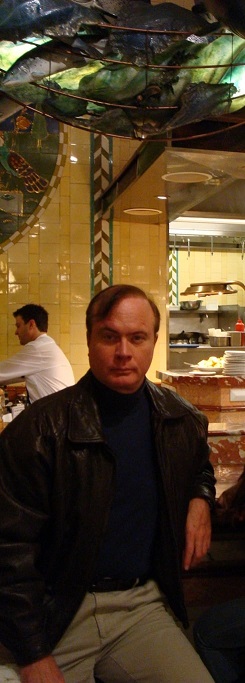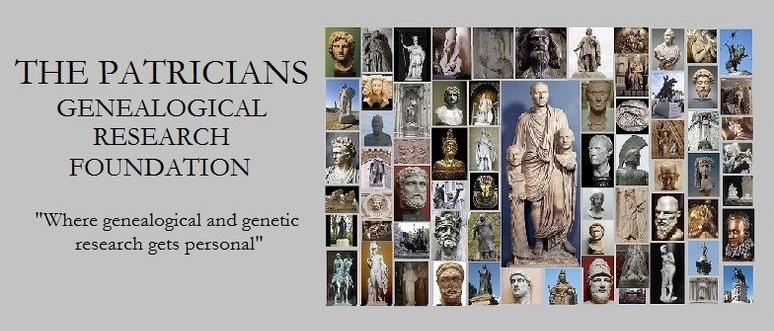






Hrothgar was lethal in battle,
His glory bound kinsmen to him,
Swelling the ranks of his warband.
Yet his mind dwelt on a prominence,
And he founded a great mead-hall,
That those here after would sing of,
Where he must deal out rings,
And protect the common wealth
And the lives of men.
And so the command flew
To the reaches of this middle-earth,
And to this house of men,
Rich adornment came.
Swiftly, by the hand of men,
It came to be build.
He, whose word is power,
Named it Heorot.
Nor did he break his word,
But dealt out rings,
And the treasure of his table.
This gabled and high towered hall,
Waited the flame and sword-hate,
Born of the malice that dwelt in the blood.
As one of the principal characters of Beowulf, Hroðgar is immortalized in English literature. The epic poem ranks as the most important work of Middle-Age Anglo-Saxon literature.
Elfhere Scylding “Beowulf”, King of Geatland (526 – 620) was his Skjolding agnatic cousin.
Hroðgar was an agnatic descendant of Sigge “Odin” Fridulfsson of Asgard (50 BC – 30 AD) 1st King of Scandinavia. Odin and his tribe emerged, probably in exile, from Gobustan, Azerbaijan to conquer all of Scandanavia before or during the first century BC.
Beowulf is alive and well in contemporary media. Dozens of adaptations of the story have been created for movies, books, and television programs–even computer games.
Sigge “Odin” Fridulfsson of Asgard (50 BC – 30 AD) 1st King of Scandinavia was his agnatic forebear..
Related ancestral blog articles
Agnatic Descendants of Sigge “Odin” Fridulfsson of Asgard (215 – 306)
Norse-Norman-Anglo-Saxon Ancestors
Hroðgar Halfdansson the Skjolding, King of Denmark
Birth 0526 in Roskilde, Denmark
Death in 0620 in Northumberland, England
Ancestry.com citation/Lineages
53rd great-grandfather COLLINS
54th great-grandfather WOODWORTH-MERRITT-SIMMONS-COLLINS
44th great-grandfather NORMANDY-D’EVREUX-MARSHALL-WARREN-CARRINGTON-HOLLAND-SIMMONS-COLLINS
45th great-grandfather YNGLING-NORMANDY-PLANTAGENET-HOWARD-WOOD-COLLINS
51st great-grandfather YNGLING-NORMANDY-D’EU-HASTINGS-HERON-COLLINGWOOD-COLLINS
5th cousin 51x removed SAXONS-WESSEX-HOWARD-WOOD-COLLINS
12th cousin 42x removed LE ROY – ROYAL BLOODLINE
13th cousin 43x removed ASGARD-HOWARD-WOOD-COLLINS
father-in-law of 8th cousin 45x removed MEROVING-ROCHECHOUART-LANDRY-CYR-BRULE
SOURCE
Beowulf: A New Verse Translation
The Patricians, A Genealogical Study – Ebook Editions (Epub, PDF & Kindle) US$5.95


Steven Wood Collins (1952 – ) Antiquarian, Genealogist, Novelist


126 replies on “Hroðgar Halfdansson the Skjolding (526 – 620) King of Denmark, Principal “Beowulf” Character”
[…] Hroðgar Halfdansson (526 – 620) King of Denmark 3GGF […]
LikeLike
[…] Hroðgar Halfdansson (526 – 620) King of Denmark 3GGF […]
LikeLike
[…] Hroðgar Halfdansson (526 – 620) King of Denmark 3GGF […]
LikeLike
[…] Hroðgar Halfdansson (526 – 620) King of Denmark 3GGF […]
LikeLike
[…] Hroðgar Halfdansson (526 – 620) King of Denmark 3GGF […]
LikeLike
[…] Hroðgar Halfdansson (526 – 620) King of Denmark 3GGF […]
LikeLike
[…] Hroðgar Halfdansson (526 – 620) King of Denmark 3GGF […]
LikeLike
[…] Hroðgar Halfdansson (526 – 620) King of Denmark 3GGF […]
LikeLike
[…] Hroðgar Halfdansson (526 – 620) King of Denmark 3GGF […]
LikeLike
[…] Hroðgar Halfdansson (526 – 620) King of Denmark 3GGF […]
LikeLike
[…] Hroðgar Halfdansson (526 – 620) King of Denmark 3GGF […]
LikeLike
[…] Hroðgar Halfdansson (526 – 620) King of Denmark 3GGF […]
LikeLike
[…] Hroðgar Halfdansson (526 – 620) King of Denmark 3GGF […]
LikeLike
[…] Hroðgar Halfdansson (526 – 620) King of Denmark 3GGF […]
LikeLike
[…] Hroðgar Halfdansson (526 – 620) King of Denmark 3GGF […]
LikeLike
[…] Hroðgar Halfdansson (526 – 620) King of Denmark 3GGF […]
LikeLike
[…] Hroðgar Halfdansson (526 – 620) King of Denmark 3GGF […]
LikeLike
[…] Hroðgar Halfdansson (526 – 620) King of Denmark 3GGF […]
LikeLike
[…] Hroðgar Halfdansson (526 – 620) King of Denmark 3GGF […]
LikeLike
[…] Hroðgar Halfdansson (526 – 620) King of Denmark 3GGF […]
LikeLike
[…] Hroðgar Halfdansson (526 – 620) King of Denmark 3GGF […]
LikeLike
[…] Hroðgar Halfdansson (526 – 620) King of Denmark 3GGF […]
LikeLike
[…] Hroðgar Halfdansson (526 – 620) King of Denmark 3GGF […]
LikeLike
[…] Hroðgar Halfdansson (526 – 620) King of Denmark 3GGF […]
LikeLike
[…] Hroðgar Halfdansson (526 – 620) King of Denmark 3GGF […]
LikeLike
[…] Hroðgar Halfdansson (526 – 620) King of Denmark 3GGF […]
LikeLike
[…] Hroðgar Halfdansson (526 – 620) King of Denmark 3GGF […]
LikeLike
[…] Hroðgar Halfdansson (526 – 620) King of Denmark 3GGF […]
LikeLike
[…] Hroðgar Halfdansson (526 – 620) King of Denmark 3GGF […]
LikeLike
[…] Hroðgar Halfdansson (526 – 620) King of Denmark 3GGF […]
LikeLike
[…] Hroðgar Halfdansson (526 – 620) King of Denmark 3GGF […]
LikeLike
[…] Hroðgar Halfdansson (526 – 620) King of Denmark 3GGF […]
LikeLike
[…] Hroðgar Halfdansson (526 – 620) King of Denmark 3GGF […]
LikeLike
[…] Hroðgar Halfdansson (526 – 620) King of Denmark 3GGF […]
LikeLike
[…] Hroðgar Halfdansson (526 – 620) King of Denmark 3GGF […]
LikeLike
[…] Hroðgar Halfdansson (526 – 620) King of Denmark 3GGF […]
LikeLike
[…] Hroðgar Halfdansson (526 – 620) King of Denmark 3GGF […]
LikeLike
[…] Hroðgar Halfdansson (526 – 620) King of Denmark 3GGF […]
LikeLike
[…] Hroðgar Halfdansson (526 – 620) King of Denmark 3GGF […]
LikeLike
[…] Hroðgar Halfdansson (526 – 620) King of Denmark 3GGF […]
LikeLike
[…] Hroðgar Halfdansson (526 – 620) King of Denmark 3GGF […]
LikeLike
[…] Hroðgar Halfdansson (526 – 620) King of Denmark 3GGF […]
LikeLike
[…] Hroðgar Halfdansson (526 – 620) King of Denmark 3GGF […]
LikeLike
[…] Hroðgar Halfdansson (526 – 620) King of Denmark 3GGF […]
LikeLike
[…] Hroðgar Halfdansson (526 – 620) King of Denmark 3GGF […]
LikeLike
[…] Hroðgar Halfdansson (526 – 620) King of Denmark 3GGF […]
LikeLike
[…] Hroðgar Halfdansson (526 – 620) King of Denmark 3GGF […]
LikeLike
[…] Hroðgar Halfdansson (526 – 620) King of Denmark 3GGF […]
LikeLike
[…] Hroðgar Halfdansson (526 – 620) King of Denmark 3GGF […]
LikeLike
[…] Hroðgar Halfdansson (526 – 620) King of Denmark 3GGF […]
LikeLike
[…] Hroðgar Halfdansson (526 – 620) King of Denmark 3GGF […]
LikeLike
[…] Hroðgar Halfdansson (526 – 620) King of Denmark 3GGF […]
LikeLike
[…] Hroðgar Halfdansson (526 – 620) King of Denmark 3GGF […]
LikeLike
[…] Hroðgar Halfdansson (526 – 620) King of Denmark 3GGF […]
LikeLike
[…] Hroðgar Halfdansson (526 – 620) King of Denmark 3GGF […]
LikeLike
[…] Hroðgar Halfdansson (526 – 620) King of Denmark 3GGF […]
LikeLike
[…] Hroðgar Halfdansson (526 – 620) King of Denmark 3GGF […]
LikeLike
[…] Hroðgar Halfdansson (526 – 620) King of Denmark 3GGF […]
LikeLike
[…] Hroðgar Halfdansson (526 – 620) King of Denmark 3GGF […]
LikeLike
[…] Hroðgar Halfdansson (526 – 620) King of Denmark 3GGF […]
LikeLike
[…] Hroðgar Halfdansson (526 – 620) King of Denmark 3GGF […]
LikeLike
[…] Hroðgar Halfdansson (526 – 620) King of Denmark 3GGF […]
LikeLike
[…] Hroðgar Halfdansson (526 – 620) King of Denmark 3GGF […]
LikeLike
[…] Hroðgar Halfdansson (526 – 620) King of Denmark 3GGF […]
LikeLike
[…] Hroðgar Halfdansson (526 – 620) King of Denmark 3GGF […]
LikeLike
[…] Hroðgar Halfdansson (526 – 620) King of Denmark 3GGF […]
LikeLike
[…] Hroðgar Halfdansson (526 – 620) King of Denmark 3GGF […]
LikeLike
[…] Hroðgar Halfdansson (526 – 620) King of Denmark 3GGF […]
LikeLike
[…] roðgar Halfdansson (526 – 620) King of Denmark 3GGF […]
LikeLike
[…] Hroðgar Halfdansson (526 – 620) King of Denmark 3GGF […]
LikeLike
[…] Hroðgar Halfdansson (526 – 620) King of Denmark 3GGF […]
LikeLike
[…] Hroðgar Halfdansson (526 – 620) King of Denmark 3GGF […]
LikeLike
[…] Hroðgar Halfdansson (526 – 620) King of Denmark 3GGF […]
LikeLike
[…] Hroðgar Halfdansson (526 – 620) King of Denmark 3GGF […]
LikeLike
[…] Hroðgar Halfdansson (526 – 620) King of Denmark 3GGF […]
LikeLike
[…] Hroðgar Halfdansson (526 – 620) King of Denmark 3GGF […]
LikeLike
[…] Hroðgar Halfdansson (526 – 620) King of Denmark 3GGF […]
LikeLike
[…] Hroðgar Halfdansson (526 – 620) King of Denmark 3GGF […]
LikeLike
[…] Hroðgar Halfdansson (526 – 620) King of Denmark 3GGF […]
LikeLike
[…] Hroðgar Halfdansson (526 – 620) King of Denmark 3GGF […]
LikeLike
[…] Hroðgar Halfdansson (526 – 620) King of Denmark 3GGF […]
LikeLike
[…] Hroðgar Halfdansson (526 – 620) King of Denmark 3GGF […]
LikeLike
[…] Hroðgar Halfdansson (526 – 620) King of Denmark 3GGF […]
LikeLike
[…] Hroðgar Halfdansson (526 – 620) King of Denmark 3GGF […]
LikeLike
[…] Hroðgar Halfdansson (526 – 620) King of Denmark 3GGF […]
LikeLike
[…] Hroðgar Halfdansson (526 – 620) King of Denmark 3GGF […]
LikeLike
[…] Hroðgar Halfdansson (526 – 620) King of Denmark 3GGF […]
LikeLike
[…] Hroðgar Halfdansson (526 – 620) King of Denmark 3GGF […]
LikeLike
[…] Hroðgar Halfdansson (526 – 620) King of Denmark 3GGF […]
LikeLike
[…] Hroðgar Halfdansson (526 – 620) King of Denmark 3GGF […]
LikeLike
[…] Hroðgar Halfdansson (526 – 620) King of Denmark 3GGF […]
LikeLike
[…] Hroðgar Halfdansson (526 – 620) King of Denmark 3GGF […]
LikeLike
[…] Hroðgar Halfdansson (526 – 620) King of Denmark 3GGF […]
LikeLike
[…] Hroðgar Halfdansson (526 – 620) King of Denmark 3GGF […]
LikeLike
[…] Hroðgar Halfdansson (526 – 620) King of Denmark 3GGF […]
LikeLike
[…] Hroðgar Halfdansson (526 – 620) King of Denmark 3GGF […]
LikeLike
[…] Hroðgar Halfdansson (526 – 620) King of Denmark 3GGF […]
LikeLike
[…] Hroðgar Halfdansson (526 – 620) King of Denmark 3GGF […]
LikeLike
[…] Hroðgar Halfdansson (526 – 620) King of Denmark 3GGF […]
LikeLike
[…] Hroðgar Halfdansson (526 – 620) King of Denmark 3GGF […]
LikeLike
[…] Hroðgar Halfdansson (526 – 620) King of Denmark 3GGF […]
LikeLike
[…] Hroðgar Halfdansson (526 – 620) King of Denmark 3GGF […]
LikeLike
[…] Hroðgar Halfdansson (526 – 620) King of Denmark 3GGF […]
LikeLike
[…] Hroðgar Halfdansson (526 – 620) King of Denmark 3GGF […]
LikeLike
[…] Hroðgar Halfdansson (526 – 620) King of Denmark 3GGF […]
LikeLike
[…] Hroðgar Halfdansson (526 – 620) King of Denmark 3GGF […]
LikeLike
[…] Hroðgar Halfdansson (526 – 620) King of Denmark […]
LikeLike
[…] Hroðgar Halfdansson (526 – 620) King of Denmark 3GGF […]
LikeLike
[…] Hroðgar Halfdansson (526 – 620) King of Denmark […]
LikeLike
[…] Hroðgar Halfdansson (526 – 620) King of Denmark 3GGF agnatic […]
LikeLike
[…] Hroðgar Halfdansson (526 – 620) King of Denmark […]
LikeLike
[…] Hroðgar Halfdansson (526 – 620) King of Denmark […]
LikeLike
[…] Hroðgar Halfdansson (526 – 620) King of Denmark […]
LikeLike
[…] Hroðgar Halfdansson (526 – 620) King of Denmark 3GGF agnatic […]
LikeLike
[…] Hroðgar Halfdansson (526 – 620) King of Denmark […]
LikeLike
[…] Hroðgar Halfdansson (526 – 620) King of Denmark 3GGF d […]
LikeLike
[…] Hroðgar Halfdansson (526 – 620) King of Denmark […]
LikeLike
[…] Hroðgar Halfdansson (526 – 620) King of Denmark […]
LikeLike
[…] Hroðgar Halfdansson (526 – 620) King of Denmark […]
LikeLike
[…] Hroðgar Halfdansson (526 – 620) King of Denmark […]
LikeLike
[…] Hroðgar Halfdansson (526 – 620) King of Denmark […]
LikeLike
[…] Hroðgar Halfdansson (526 – 620) King of Denmark […]
LikeLike
[…] Hroðgar Halfdansson (526 – 620) King of Denmark […]
LikeLike
[…] Hroðgar Halfdansson the Skjolding (526 – 620), King of Denmark, Principal “Beowulf̶… […]
LikeLike
[…] Hroðgar Halfdansson the Skjolding (526 – 620), King of Denmark, Principal “Beowulf̶… […]
LikeLike
[…] Hroðgar Halfdansson the Skjolding (526 – 620), King of Denmark, Principal “Beowulf̶… […]
LikeLike